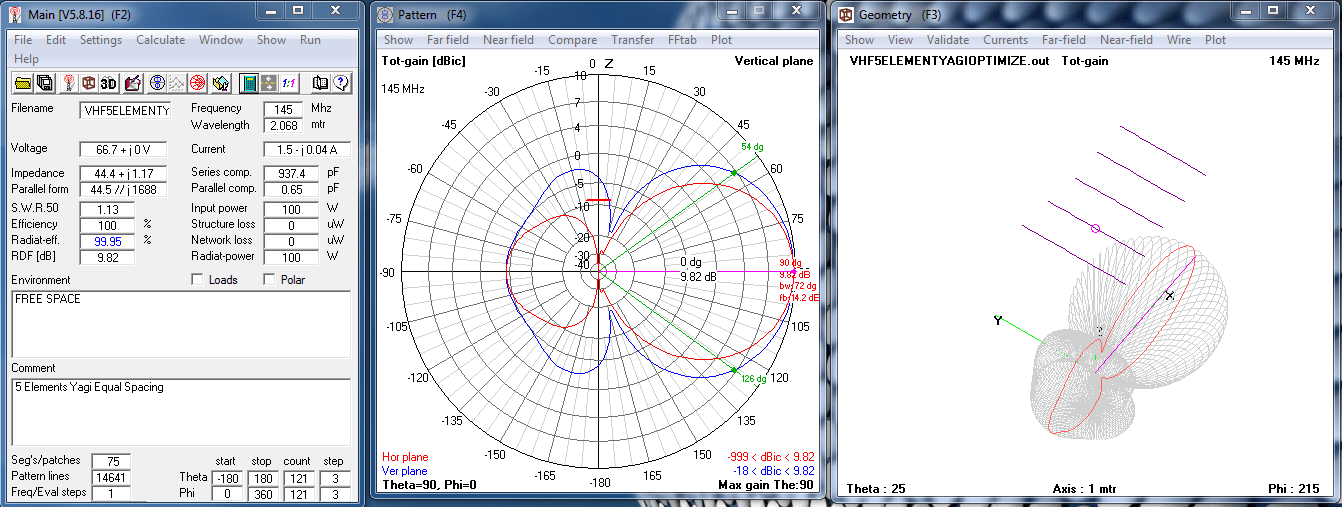
Figure9- Figure10. Figure 11 Figure12.

- Software / Version / Author: Type of Yagi Design: Input/Open/Import File Formats: Save/Export File Formats: Price: 4NEC2 version 5.8.14 Arie Voors: includes sample Yagi and other antenna files, full pattern and gain analysis.nec.ez (EZNEC).ant (AO).nec.txt: Free: EZNEC version 5 Roy Lewallen W7EL: includes sample Yagi and other antenna files.
- YAGI is a software application whose main purpose is to help you learn more about Yagi-Uda antennas, by calculating the values for multiple parameters. The advantages of a portable app.
- Welcome to 2021 and Advanced Optimized Wideband Antenna Yagi Designs by G4CQM. G4CQM was the original founder of PowAbeam Antennas way back in early 1994, handing over the reins to Roger Banks GW4WND of The DXShop (ready made yagis) and Richard Mason G6HKS (kits and parts) during 2012. This Web site contains the official repository of the.
Free Yagi Antenna Design Software Windows 10
The really great thing about amateur radio as a hobby is the staggering number of opportunities for creative problem solving and DIY projects. Once you dive into the field and start exploring, you discover niche interests that most strongly appeal to you. As you continue on this journey, you might find yourself wondering how to customize your equipment to best suit your needs. I got into amateur radio through the wonderful world of Summits On The Air, and I was immediately hooked on it. I like activating summits on VHF, and to improve my chances of making contacts, I would take my Arrow 2m/70cm Yagi with me. After a couple of hikes with the antenna though, it started to dawn on me that it was quite bulky and added a not insignificant amount of weight to my backpack. As I was exploring options to remedy this, I came across this amazing yagi build by Adam K6ARK. It is a reflector-less three element Yagi made out of aluminium arrow shafts. If you, dear reader, are interested in building a similar antenna, I highly recommend it.

Being duly impressed by the build, I decided to make one myself, with a couple of modifications. Adam has been kind enough to share the MMANA-Gal file for the antenna in the video description, which I downloaded, along with the MMANA-Gal software. The basic version of MMANA-GAL is free to download, and is very useful for basic antenna design. I started with Adam’s design as a base, and started experimenting with element lengths and placement. My one constant was the length of the driven element, which I was going to re-use from my Arrow 2m/70cm Yagi. I wanted to keep the construction as simple as possible, as I’m not very gifted mechanically speaking, and the Arrow Yagi element comes with a gamma match built in. With that fixed, it was relatively simple to optimize the other two elements for 2m and 70cm. MMANA’s ‘Optimize’ function came in very handy in this. The SWR was a little high for 70cm, and the capacitive reactance is high as well, but this is something I can live with, as I will be using the antenna primarily on 2m. You can find the Gal file for my version here.

With the design in hand, I was ready to start building. I put a parts list together and gathered all the needed materials. The second design modification was replacing the arrow shaft boom with a 1/2 inch PVC pipe. I figured that this would simplify the construction process, and holding it in my hand would be easier too, without the need for a handle.
Parts List:
- 1/2″ PVC pipe, 2ft: https://www.lowes.com/pd/Charlotte-Pipe-1-2-in-dia-x-10-ft-L-600-PSI-PVC-Pipe/3133079
- Threaded rods: https://www.mcmaster.com/95412A882/
- Arrow shafts: https://amzn.to/3oDgpuM
- Threaded inserts: https://www.amazon.com/gp/product/B07FS2SN2H/ref=as_li_qf_asin_il_tl?ie=UTF8&tag=k6ark-20&creative=9325&linkCode=as2&creativeASIN=B07FS2SN2H&linkId=d00e358f0682c12148556671a27a02cc
I started putting the antenna together by first drilling three holes in the pvc pipe at the calculated distances. I wanted to use a drill press to do this, as I wanted to get them as straight as possible. The only problem, I do not have a drill press. Luckily for me, a friend has one, and he was kind enough to let me use it. The holes were not as aligned as I hoped, but they were good enough for a first project. Next, I marked four aluminium arrow shafts and at needed lengths and cut them with a pipe cutter. Once they were cut and prepared, I added the aluminium shaft insets and crimped them into place. The arrows shafts will be held in place on the boom using threaded rods. I capped off the boom on both ends with vinyl end caps and the antenna was complete.
A 5 ft length of rg174 cable serves as a feedline, which will be affixed to the boom with zip ties. Finally, I measured the vSWR and found it to be quite acceptable, but the resistance was a little lower than I would have liked, around 146 MHz and 420 MHz. On a hunch, I replaced the smaller director with the small director from the Arrow Yagi. Lo, and behold, the resistance climbed back to around 50Ω!

I am quite proud of this build, even if two of components is from a store bought antenna. I tested it out this weekend on two SOTA activations, and I was very happy with it. The pvc boom is so much lighter, and the performance is more or less the same as the Arrow, with the added advantage of not having to carry the 70cm elements with me. It is the first antenna I have built, in fact, it is one of the first things I have built, period. It is so rewarding to build something with one’s own hands, and much more so if it works! The entire process, shopping for parts, anxiously waiting for them to be delivered, designing, optimizing, and finally constructing, was incredibly enjoyable. Addicting too. I cannot wait to get started on my next project!
73!
Yagi Antenna Design
K6ARV